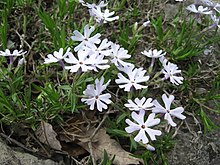
Phlox is a genus of 68 species of perennial and annual plants in the family Polemoniaceae. They are found mostly in North America in diverse habitats from alpine tundra to open woodland and prairie. Some flower in spring, others in summer and fall. Flowers may be pale blue, violet, pink, bright red, or white. Many are fragrant.
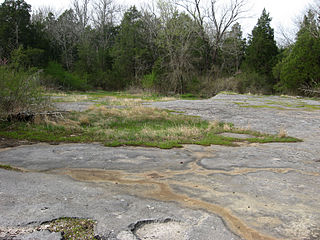
A calcareous glade is a type of ecological community that is found in the central Eastern United States. Calcareous glades occur where bedrock such as limestone occurs near or at the surface, and have very shallow and little soil development. Due to the shallow soil and the extreme conditions created by it, trees are often unable to grow in the glades. This creates a habitat that is usually sunny, dry, and hot. Calcareous glade vegetation is more similar to that of a desert habitat than a grassland, being dominated by small spring annuals with occasional geophytic or succulent perennials.

Liatris aspera is a perennial wildflower in the Asteraceae family that is found in central to eastern North America in habitats that range from mesic to dry prairie and dry savanna.

Hypoxis hirsuta, commonly known as common goldstar, common star-grass, eastern yellow stargrass, yellow star grass, or yellow star flower, is a perennial ornamental plant in the family Hypoxidaceae. Sometimes this plant is placed in the family Amaryllidaceae or the family Liliaceae. The species is native to the United States, Canada, and northeastern Mexico.

Sabatia angularis, commonly called rosepink, rose pink, square-stem rose pink or rose gentian is a biennial flowering plant in the Gentianaceae (gentain) family. It is native to central and eastern North America.

Phlox hoodii, the spiny phlox or carpet phlox, is a species of phlox. It is a plant of western North America, where it is a common flower in sagebrush country, mostly growing in dry lithosol habitats. It is among the first plants to bloom in spring, after the snow has melted. Its distribution extends from Alaska to Arizona. There are many subspecies.
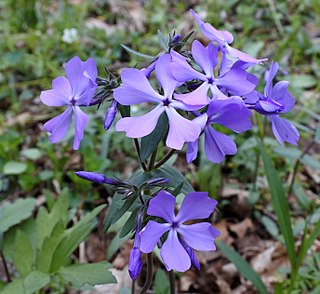
Phlox divaricata, the wild blue phlox, woodland phlox, or wild sweet william, is a species of flowering plant in the family Polemoniaceae, native to forests and fields in eastern North America.

Nemastylis geminiflora, commonly known as prairie celestial, celestial, prairie pleatleaf, or celestial lily is a perennial herb in the Iridaceae (iris) family. It is native to the south-central area of the United States.

Echinacea simulata, commonly called wavy leaf purple coneflower, glade coneflower, or prairie purple coneflower, is a species of perennial flowering plant in the family Asteraceae. It is native to the east-central states of the United States. Its natural habitat is dry, calcareous, open areas such as barrens and woodlands.

Aconitum columbianum is a species of flowering plant in the buttercup family known by the common names Columbian monkshood or western monkshood.

Phlox paniculata is a species of flowering plant in the phlox family (Polemoniaceae). It is native to parts of the eastern and central United States. It is extensively cultivated in temperate regions as an ornamental plant and has become established in the wild in scattered locales in other regions. Common names include fall phlox, garden phlox, perennial phlox, summer phlox, and panicled phlox.

Gilia capitata is a species of flowering plant in the phlox family known by the common names blue-thimble-flower, bluehead gilia, blue field gilia, and globe gilia.

Phacelia sericea, the silky phacelia, blue alpine phacelia, or purple fringe, is a showy perennial species of Phacelia endemic to western North America. It grows mainly at subalpine to alpine elevations in forest openings or above treeline among rocks and sand. Sericea comes from the Latin sericeus, or silky, referring to the fine hairs on the leaves and stem.

Tephrosia virginiana, also known as goat-rue, goat's rue, catgut, rabbit pea, Virginia tephrosia, hoary pea, and devil's shoestring is a perennial dicot in family Fabaceae. The plant is native to central and eastern North America.

Polemonium occidentale is a species of flowering plant in the phlox family known by the common names western polemonium and western Jacob's-ladder. There are two subspecies. The common ssp. occidentale is native to western North America from British Columbia to Colorado to California, where it can be found in moist areas of many habitat types, including meadows and woodlands. There is also a rare subspecies, ssp. lacustre, which is known only from a total of three counties in Minnesota and Wisconsin, and is found only in white cedar swamp habitat there.

Triodanis perfoliata, the clasping Venus' looking-glass or clasping bellflower, is an annual flowering plant belonging to the family Campanulaceae. It is an annual herb native to North and South America, the natural range extending from Canada to Argentina. It is also naturalized in China, Korea and Australia.

Buchnera americana, commonly known as American bluehearts or bupleurum, is a locally endangered herbaceous perennial plant of the broomrape family Orobanchaceae. Found widely across the eastern United States, it also occurs in one location in the Canadian province of Ontario.
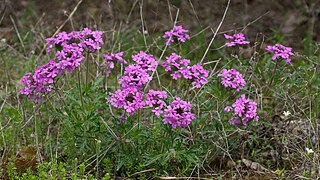
Verbena canadensis, commonly known as rose mock vervain, rose verbena, clump verbena or rose vervain is a perennial herbaceous flowering plant in the verbena family (Verbenaceae) with showy pink to purple flowers.. It is native to the eastern and south-central areas of the United States. This species is widely cultivated as an ornamental, and naturalized populations have been established outside its native range, such as in the northeastern U.S.
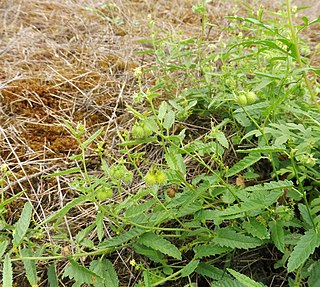
Tragia betonicifolia, commonly called betonyleaf noseburn, is a species of flowering plant in the spurge family (Euphorbiaceae). It is native to North America, where it is primarily found in the South-Central region of the United States extending north into Kansas and Missouri, with disjunct populations east in Tennessee. Its typical natural habitat is dry areas with sandy or rocky soil, in glades, prairies, bluffs, and dry woodlands.
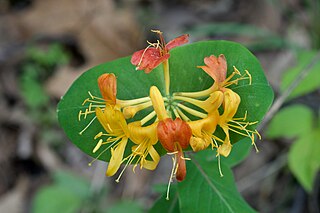
Lonicera flava is a species of honeysuckle native to the central and eastern United States. It is a woody vine with yellow-orange flowers that are slightly fragrant.
